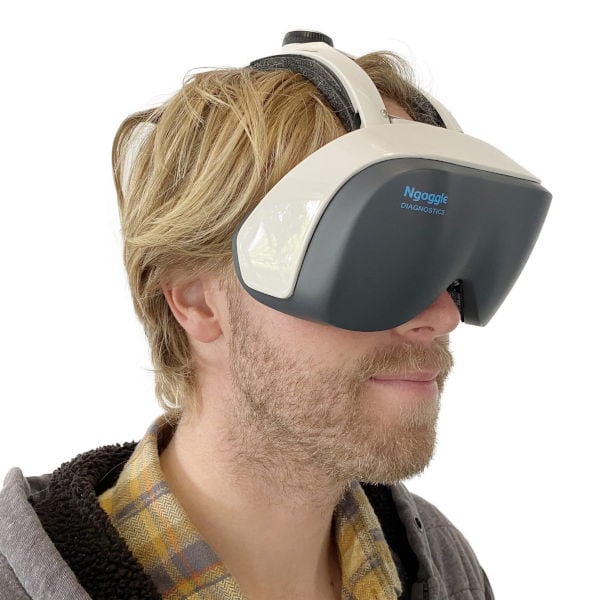Don’t feel alone if your head’s spinning like a scene out of the Exorcist. But great scientific strides are being made in which glaucoma — one of the leading causes of blindness in people over 60 — can be recognized before it damages the optic nerve. The optic nerve sends messages from the retina to the brain; damage to the nerve drastically and irreversably impacts your vision.
Keep in mind that many forms of glaucoma have no warning signs. So, people may not notice changes in vision until the condition is advanced and the impairment is permanent.

What is glaucoma?
Glaucoma is a collection of eye conditions that damage the optic nerve, which is vital for good vision. This destruction is often caused by abnormally high pressure in the eye.
It is estimated that there are currently over 67 million cases of glaucoma worldwide— the likelihood of having glaucoma increases with age. Nearly 10% of people aged 70 and up suffer from glaucoma.
Some signs of glaucoma include blind spots in your side or peripheral vision, tunnel vision, and central vision loss.
There are four types of glaucoma: open-angle glaucoma, narrow-angle glaucoma, secondary glaucoma, and congenital glaucoma.
Glaucoma risk factors include:
- skipping regular eye exams
- family history of glaucoma
- age
- ethnicity
- high blood pressure
- diabetes
Vision loss due to glaucoma cannot be recovered. Until now, regular eye exams and standard glaucoma tests have been the only way to diagnos it. Glaucoma testing includes pachymetry (corneal thickness test), gonioscopy (angle tests), optic nerve imaging, and tonometry (eye pressure test).
A video game that helps diagnose glaucoma?
Nobody is lining up to get extra eye tests, even if they could help save your future vision. Luckily, scientists in Japan have developed a video game that makes early detection of glaucoma fun.
Meteor Blaster is a free smartphone, browser-based shooting game, the brainchild of Sendai Television and the Tohoku University Graduate School of Medicine.
Patented last July, the game detects early glaucoma symptoms after playing for only five minutes.
The game is played by holding a smartphone about a foot away from the face. A stationary laser cannon is used to shoot meteoroids as they drift into the cross-hairs. When the user sees white dots appear on the screen, they press the “Capture” button and go for a high score.
The game functions in much the same way as a standard automated perimetry (SAP) test that eye doctors already use in glaucoma diagnosis.
After playing through four stages, Meteor Blaster gives the user an analysis of their vision in each eye. The screen is divided into 16 sections and a score from one to five is assigned to each area. Scoring one means your eyes are healthy, while five means your vision is terrible at detecting objects.
A score of five means the user could be in the early stages of glaucoma and should consult an eye doctor.
The game takes very little time to play but can save the user a great deal of grief down the road.
The future: video and TV stimulation to regenerate the optic nerve
Though still in the experimental stage, scientists are also exploring ways to help patients whose glaucoma has already damaged the optic nerve.
A study at the Glaucoma Research Foundation questioned whether optic nerve damage had to be permanent. To this end, the study combined gene therapy with visual stimulation.
The scientists knew that increased activity of a protein called mTOR promoted some regeneration of the optic nerve. They wondered if that protein could be enhanced by adding increased visual stimulation.
They began by using gene therapy on laboratory mice with damaged optic nerves using the mTOR protein. After two weeks, they placed the mice in a chamber for several hours a day for three weeks to view changing patterns of high-contrast black lines.
The exciting results showed healing in the optic nerve and resumed neural contact with the brain. Reconnecting neurons in the visual system has been one of the biggest challenges to developing regenerative therapies for blinding eye diseases like glaucoma.
The next step is to see what visual stimulation works specifically on glaucoma and best regenerates the optic nerve. Future therapies could include video games and television programs to deliver regeneration-inducing visual stimulation.
A virtual reality glaucoma treatment ahead?
Scientists at Duke University are conducting studies that include a wearable brain-based device called NGoggle. The device incorporates virtual reality that may improve glaucoma diagnosis and prevent vision loss.

The device consists of head-mounted virtual reality goggles that use light to stimulate targeted areas in the patient’s visual field. NGoggle’s portability means that it could be used in various environments — such as an eye care provider’s office, a community center, or a person’s home — with test results available immediately.
Unlike SAP, the NGoggle assesses peripheral vision loss without requiring input from the patient. NGoggle gauges brain activity in response to signals received from the eyes. Diminished activity during a visual field test may indicate cornea damage and functional loss from glaucoma.
The virtual reality goggles are integrated with wireless electroencephalography (EEG), a series of electrodes that adhere to the scalp and measure brain activity. Within a few minutes, the NGoggle algorithm captures and analyzes enough data to report how well each eye communicates with the brain across the patient’s field of vision.
There may come a day when people could be tested for glaucoma while they play a VR-based video game!
Worried about glaucoma? Talk to Assil Gaur Eye Institute
While there is no cure for glaucoma, expert care can slow its progression. Treatment options are influenced by how advanced the disease is and whether the patient is an appropriate candidate for a given treatment.
The Assil Gaur Eye Institute is nationally recognized for its compassionate, patient-centric care, commitment to pioneering advances in ophthalmology, and dedication to supporting patients’ health and well-being.
Please call (866) 945-2745 or make an appointment online.
We are conveniently located for patients throughout Southern California and the Los Angeles area at locations in or near Beverly Hills, Santa Monica, West Los Angeles, West Hollywood, Culver City, Hollywood, Venice, Marina del Rey, Malibu, Manhattan Beach, and Downtown Los Angeles.













